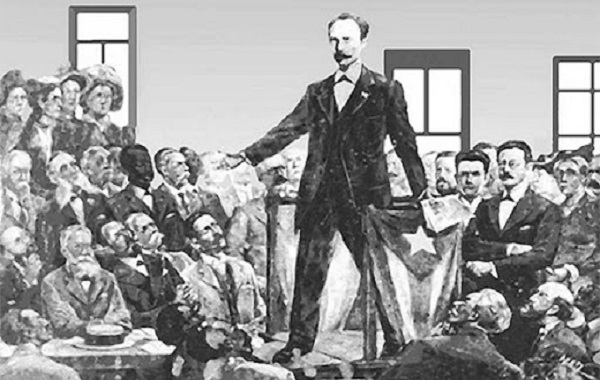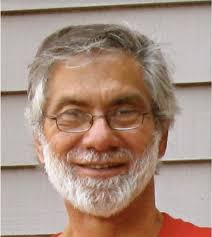
The neighborhoods around Union Square and 14th Street witnessed fervent cultural and political activity by Cuban exiles in the 19th century. José Martí played a major role. In this, our third annual walking tour, we will stop by relevant places in that area, and talk about Martí’s essays that have left a significant impact on the intellectual development of Latin America. We will also read and comment on some of the best-known poems from the book Ismaelillo (1882), which Martí dedicated to his son Pepito, and poems from the book Versos Libres (1891).
After assembling by the Lincoln Monument, we will move to the southern part of the Square, with a brief commentary on the journal La América (at 856 Broadway), where Martí worked as staff writer and later editor, from 1882-83. This was a monthly newspaper that was distributed throughout Latin America, in which Martí began circulating his ideas. We will then walk by the former site of Steinway Hall, at 71-73 East 14 th St., where two of Cuba’s greatest musicians, the violinist José White and the pianist Ignacio Cervantes, offered three duet concerts in October 1875, to raise funds for Cuban independence during the Ten Years’ War.
We will then walk by the site where Steck Hall stood. There José Martí gave his first speech in New York City, on January 24, 1880, titled “Today’s Situation in Cuba and the Current Outlook in Spanish Politics,” also known as “The Steck Hall Lecture.” Then our walking tour will proceed to Irving Hall, located at Irving Place and 15 th St., where Emilia Casanova de Villaverde bestowed on General Manuel Quesada y Loynaz a ceremonial sword, on behalf of the Liga de las Hijas de Cuba, to recognize his courage and heroism. On that same street, Irving Place, stood the Westminster Hotel and Hotel America, where Puerto Rican patriot and educator Eugenio María de Hostos, founded the League of Puerto Rican Patriots in 1898.
We will then walk to 17 East 16 th St., the first location of the bookstore Las Américas, whose proprietor, Néstor Ponce de León, was an outstanding intellectual and printer. A block away, on 36 West, on the same street, there is the Church of St. Francis Xavier, one of the most frequented by Cuban exiles, and where, in 1875, the funeral service of Francisco Vicente Aguilera, vice-president of the Republic of Cuba in Arms, took place. Finally, our walk will take us to the site where the Hotel Fénix was located, at 111-113 West 14th Street, where Martí’s wife, Carmen Zayas-Bazán, and their son, José Francisco, stayed there for two months (June 31-Aug. 27, 1891) with Martí, in a last unsuccessful attempt at reconciliation.
We will end our caminata with a Cuban lunch (at participants’ own expense), at Coppelia Restaurant, at 207 West 14 th St., close to 7 th Ave.
The walking tour will be led by ethnologist Elena Martínez (City Lore) and Dr. Orlando José Hernández (professor emeritus, Hostos College, CUNY).
RECOMMENDED READING: El Martí que yo conocí, by Blanche Zacharie de Baralt, which can be accessed online through the following link: https://www.patrialibros.org/book/2229
Of special interest: “El patriota” (p. 12), “El hombre” (p. 25), “El artista” (p. 29) and “New York” (p. 55).
This event is part of our CreateNYC Language Access Series on Cuban History, Art, and Literature. It will be held in English and Spanish.
FREE ADMISSION
To sign up for the tour:
Send an email with name(s) and cell phone number(s) to: info@cubanculturalcenter.org
Meeting place and time: We will meet at 10 AM, in Union Square, at the level of 16th Street, between Union Square East and Union Square West, in front of the Lincoln Monument.
(Subway trains 4, 5, 6, L, N, Q, R, and W)
Wear comfortable clothing, appropriate to the weather, walking shoes, and umbrella or hat for the sun (if necessary), and a couple of bottles of water.

Orlando José Hernández, PhD, is Professor Emeritus of Hostos Community College-CUNY and co-coordinator of the Hostos 180 National Commission. Born in Puerto Rico, he has excelled as a writer and translator, and is widely considered one of the leading scholars on Eugenio María de Hostos‘s work, having recovered numerous unpublished and uncollected works by the multifaceted Puerto Rican writer and patriot. Hernández is the author of various critical essays on contemporary Latin American and Spanish authors, among them, José Lezama Lima, Hugo Margenat, Dionisio Cañas, David Cortés and Alfredo Margenat. He has also published several notable translations: En barco de papel/In a Paper Boat, by Eugenio María de Hostos; Antología, by Elizabeth Bishop; Hungry Dust/Polvo hambriento, by Graciany Miranda Archilla; and the forthcoming books New York Fragments by Dionisio Cañas, and ¿Quién preside? by Hostos. His most recent book includes rescued texts by Hostos, published under the title: Documentos de la Liga de Patriotas Puertorriqueños. He is presently working on Correspondencia entre Eugenio María de Hostos y el Dr. Manuel Guzmán Rodríguez, 1898-1903. Both works have been included in Cuadernos Hostosianos, sponsored by Comisión Nacional Hostos 180. Dr. Hernández presently resides in Hoboken, New Jersey and Río Piedras, Puerto Rico.

Elena Martínez is the Artistic Director of the Bronx Music Heritage Center a gallery and performance space which presents programs celebrating the Bronx’s musical and artistic legacy. She received a MA in Anthropology and an MA in Folklore from the University of Oregon and has been a Folklorist at City Lore since 1997 where her work included getting Casa Amadeo (the longest continually-run Latin music store in NYC) nominated to the National Register of Historic Places (the first nomination relating to the Puerto Rican experience on the mainland); and nominated master Puerto Rican lacemaker (the art of mundillo) Rosa Elena Egipciaco for a NEA National Heritage Award. She co-produced the documentary, From Mambo to Hip Hop: A South Bronx Tale, which aired on PBS in September 2006 and won the NCLR’s (National Council of La Raza) 2007 ALMA Award for Best TV Documentary. She was a producer for the documentary, We Like It Like That: The Story of Latin Boogaloo, which premiered at the SXSW Festival in 2015. She was also a producer on the short documentary, Eddie Palmieri: A Revolution on Harlem River Drive (Red Bull Academy 2016). Elena curated the exhibition, “¡Que bonita bandera!: The Puerto Rican Flag as Folk Art,” and was the Assistant Curator for the exhibit, “Nueva York: 1613-1945” at El Museo del Barrio (2010). She co-curated the exhibit, Las Tres Hermanas: Art & Activism, with Joe Conzo Jr. which was featured at the Bronx Music Heritage Center and the Center for Puerto Rican Studies in 2017.
This event is supported, in part, by public funds from the New York City Department of Cultural Affairs in partnership with the City Council, and made possible by the New York State Council on the Arts and the New York State Legislature.
![]()
![]()
With the promotional cooperation of
 and
and
![]()
[Image above: José Martí at Steck Hall, January 24, 1880 (La Damajagua)